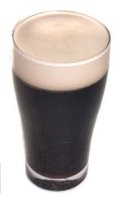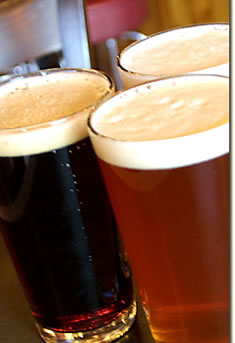Llama School
When winter rolls around, and I'm working on insulating myself from the nasty bitter wind that blows, I drink a lot of *dark* beers. I know some of you are not fans of the dark brews. But I think it is because you are afraid. Be not afraid. A beer sort of girl will take you by the hand, and show you the dark side. It is not evil. It is rich, comforting, and delicious. So sit up straight, and be sure to grab your pens, pencils, paper, or if you insist on being all digital, your keyboard. You're about to get some learnin'.
Beer school is now in session. Here are a few types of dark beers, and how I describe them. In all fairness, I describe them this way because the Alström Bros explain things so perfectly, and they always nail it. Porter - The porter style of beer is responsible for the cartoon image of a drunk swigging from a jug marked XXX. X's were used to denote strength, so one X would be less strong than XX. So you know this style of beer is OLD SCHOOL. It is also the father of the stout. Porter brewers learned that they could roast grains to make them dark, and this turned into the stout. Porters are dark, no doubt, but typically aren't made with roasted grains, and so have a slightly simpler taste. They're a little dry, like wine, but they pack a powerful taste punch. Just because they are dark does not mean they are the strongest beer around. Usually they are on par with your everyday average domestic light in a bottle variety of beer.
Porter - The porter style of beer is responsible for the cartoon image of a drunk swigging from a jug marked XXX. X's were used to denote strength, so one X would be less strong than XX. So you know this style of beer is OLD SCHOOL. It is also the father of the stout. Porter brewers learned that they could roast grains to make them dark, and this turned into the stout. Porters are dark, no doubt, but typically aren't made with roasted grains, and so have a slightly simpler taste. They're a little dry, like wine, but they pack a powerful taste punch. Just because they are dark does not mean they are the strongest beer around. Usually they are on par with your everyday average domestic light in a bottle variety of beer.
Stout - (my fave) - I described it in last week's beer post, but boiled down, this is a very very dark beer, that makes someone think about something rich, like coffee or toffee or chocolate. It isn't sweet like fruit beers can be, it can feel almost dry when compared to light colored beers. The main flavor of a stout comes from roasted barley. Carbonation is usually minimal in stouts, which is why they are usually put on a nitro tap in bars. The nitro sytem is what is responsible for that creamy, masking effect that makes pouring a Guinness so fun to watch. The big 3 are Murphy's, Guinness and Beamish.
Oatmeal Stout - A variation of the traditional stout, this came about when people thought that adding oats to the brewing mix would make the beer healthier. The side bonus is that oatmeal stouts tend to be a litle sweeter than traditional stouts. What you get is a very silky-smooth beer that has a BIG taste, but doesn't feel like you should have to chew it. Tonight, however, I'm drinking another regular old stout. Because I like them! And I feel like I've earned it. I worked out today and everything. So there. Today's beer is Bridgeport Brewery's Black Strap Stout. I opened this beer almost 15 minutes ago, and then got side tracked by this stupid post. So it's been sitting awhile with only a few sips taken, and the head is still almost an inch thick. Regardless of how long I left it there, I have a feeling that it would leave lacy trails all the way down the glass as I drank it. (That's a good thing!) It totally smells like chocolate and coffee, with almost a cocoa taste immediately hitting me. After that dissolves, there's a little bitter kick of hops, with some molasses, and a dry, i-need-to-drink-more-now feeling left in my mouth.
Tonight, however, I'm drinking another regular old stout. Because I like them! And I feel like I've earned it. I worked out today and everything. So there. Today's beer is Bridgeport Brewery's Black Strap Stout. I opened this beer almost 15 minutes ago, and then got side tracked by this stupid post. So it's been sitting awhile with only a few sips taken, and the head is still almost an inch thick. Regardless of how long I left it there, I have a feeling that it would leave lacy trails all the way down the glass as I drank it. (That's a good thing!) It totally smells like chocolate and coffee, with almost a cocoa taste immediately hitting me. After that dissolves, there's a little bitter kick of hops, with some molasses, and a dry, i-need-to-drink-more-now feeling left in my mouth.







